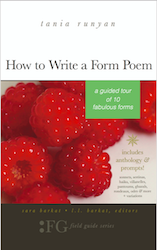Traveling to the Triolet, Rondel, and Rondelet
Sure, I’m willing to admit that How to Write a Form Poem has catapulted me to international fame, prompting the US National Park Service to rethink that whole tradition of having presidents, not poets, on Mount Rushmore. But allow me to take a quick break from negotiating with next year’s Super Bowl Halftime planners to emphasize that the newest “How To” guide from T.S. Poetry Press is the result of a collaborative effort.
The book would be nothing without the contributions of so many outstanding poets, whose sonnets, villanelles, haiku, ghazals, and many other forms bring delight, instruction, and inspiration to the pages. But L.L. Barkat and Sara Barkat, editors extraordinaire, really brought this book to a higher level with some pretty intense behind-the-scenes work.
Aside from the usual editing tasks, these two expended an enormous bundle of poetic energy to help conceptualize the book, round out some of my explanations of form, write many of the exercises that appear in the “More Stops” section of the book, hunt down poems, translate poems (yes—there are several original translations in the book!), and add the “Go the Extra Mile” sections to challenge some of the more advanced poetry practitioners using the book.
A couple weekends ago, I took a little time out to learn from my own book. It’s been a pleasure bringing attention to the rondeau, an oft-forgotten little French form that really sings. In the “Go the Extra Mile” section at the end of the rondeau chapter, Sara Barkat ushers in even more fun by introducing the rondeau-inspired variants: the triolet, rondel, and rondelet. One afternoon, on a little solo writing retreat, I challenged myself to try all three of these variants for the first time.
It was fun. And difficult. And difficult in the most fun of ways. I actually felt my brain cells expanding while I tested out the sonic properties of my word choices and rhythms, counting syllables, listing rhymes, and, yes, talking to myself (as any good poet should). While the three-poems-in-one-day project may not have resulted in any masterpieces, it resulted in three poems that did not exist before, in variations I had never tried, and with a recharged imagination raring to go round and round these poems again as I revise and create even more.
I’ll let you take a look at my draft of a rondel. Was the gas station logo imagery inspired by my affinity with Elizabeth Bishop, author of the poem Filling Station, by my devotion to road trips (note that I freely mix logos from brands in different regions of the country), or by the fact that my Airbnb room faced a Shell station whose vibrant sign pulsed its primary-colored light through the blinds at all hours? That will be a mystery I’ll save for my interviews on the late-night talk show circuit.
Finally, a Gas Station!
A scallop shell lights up that sign,
but down the street, a dinosaur
and ball-capped beaver wage a war
of twofer chips or stale Red Vines
and bottled syrup just in time
to quench our need for lousy more.
A scallop shell shines on that sign,
and down the street, a dinosaur
can’t see behind his hulking spine
encroaching hearts and geese and stars.
Whimsy beats down our Honda’s door
till the miracle escapes my mind,
that scallop lighting up a sign.
Photo by John Fowler, Creative Commons license via Flickr. Post by Tania Runyan.
BUY ‘HOW TO WRITE A FORM POEM’ NOW!
- Flowers of California: California Poppy - December 8, 2022
- Flowers of California: Lily of the Nile - October 13, 2022
- Flowers of California: Crape Myrtle - October 5, 2022


Bethany Rohde says
“While the three-poems-in-one-day project may not have resulted in any masterpieces, it resulted in three poems that did not exist before, in variations I had never tried, and with a recharged imagination raring to go round and round these poems again as I revise and create even more.” What a generative experience, Tania! 🙂
I’m thinking of dipping my toe into writing a form that’s new to me thanks to the How to Write a Form Poem-Extravaganza (book, Zoom reading, poetry interviews and comments). Grateful for all the work that went into this book!
Tania Runyan says
I look forward to hearing about the poems *you* generate, Bethany! Happy writing!